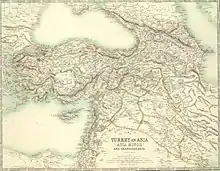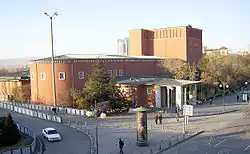The following is a timeline of the history of the city of Ankara, Ankara Province, Turkey.
Prior to 14th century
| History of Turkey |
|---|
 |
| Timeline |
|
|
- 546 BCE – Achaemenid Persians in power (approximate date).[1]
- 334 BCE – City taken by forces of Alexander III of Macedon.[1]
- 278 BCE – Celtic Galatians in power.[2]
- 25 BCE – City taken by forces of Augustus and becomes part of the Roman Empire.[2]
- 20 BCE – Monumentum Ancyranum built.
- 3rd century CE – City besieged by Gothic forces.
- 272 CE – City becomes part of Roman Empire again.
- 314 – Church council held.
- 362 – Julian (emperor) of Roman Empire visits city; "Column of Julian" erected.[2]
- 7th century – City becomes capital of the Opsician Theme.
- 8th century – City becomes capital of the Bucellarian Theme.
- 1073 – City becomes part of the Seljuq Empire.
- 1101 – Ankara Castle captured by the Crusaders.
- 1227 – Ankara Castle captured by the Seljuqs.
14th–19th centuries
- 1356 – City taken by forces of Ottoman Orhan I.[2]
- 1402 – 20 July: Battle of Ankara fought at Çubuk; Turkic Timur takes city.[3]
- 1403 – Ottomans in power again.
- 1471 – Mahmut Paşa Bedesteni built.
- 1523 – Çengel Han built.
- 1566 – Cenabi Ahmed Pasa Mosque built.[4]
- 1688 – Earthquake.[1]
- 1832 – Ankara Castle renovated.
- 1864 – City becomes capital of the Ankara Vilayet.[5]
- 1890 – Population: 27,825 (approximate).[5]
- 1893 – Istanbul-Ankara railway constructed.[1]
20th century
- 1920
- 23 April: Government of the Grand National Assembly established.
- Hakimiyet-i Milliye newspaper begins publication.[6]
- 1923
- 13 October: City becomes capital of the Republic of Turkey.[5]
- Gençlerbirliği S.K. football club formed.
- 1924
- Population: 35,000 (approximate).
- Musiki Muallim Mektebi opens.
- Presidential Symphony Orchestra headquartered in Ankara.
- 1925
- Forest Farm established.
- Pembe Köşk becomes Turkish presidential residence.
- 1927
- Ankara Palas opens.[7]
- Population: 44,553.
- Victory Monument erected.[2]
- 1930
- City renamed "Ankara."[1]
- Ethnography Museum of Ankara founded.
- State Art and Sculpture Museum built.
- 1932 – Pink Villa built.
- 1933 – Ankara Zoo established.
- 1935 – Ankara 19 Mayıs Stadium built.
- 1937 – Ankara Central Station inaugurated.
- 1938 – November: State funeral of Mustafa Kemal Atatürk held.
- 1940 – State Conservatory established.
- 1943 – Gençlik Parkı (park) and Museum of Anatolian Civilizations opens.
- 1945 – Population: 226,712.[8]
- 1946 – University of Ankara founded.[1]
- 1948 – Ankara Opera House inaugurated.
- 1950 – Population: 286,781.
- 1953 – Anıtkabir mausoleum of Atatürk erected.
- 1955 – Esenboğa Airport begins operating.
- 1956 – Middle East Technical University.[1]
- 1961 – Turkish Grand National Assembly Museum opens.
- 1967 – Hacettepe University founded.[5]
- 1971 – Barıṣ newspaper begins publication.[6]
- 1973 – Population: 1,461,345 city; 1,553,897 urban agglomeration (approximate).[9]
- 1974 – Yenikent Asaş Stadium built.
- 1978 – 9 October: Bahçelievler massacre.
- 1982 – 7 August: Esenboğa International Airport attack.
- 1983 – 16 January: Airplane accident.
- 1984
- City administration reorganized.[10]
- Mehmet Altınsoy becomes mayor of Greater Ankara.
- Bilkent University founded.[1]
- Turkish Aerospace Industries headquartered in Ankara.
- Population: 2,019,000 (estimate).[11]
- 1987 – Kocatepe Mosque built.
- 1989
- National Assembly Mosque[12] and Atakule Tower[2] built.
- Murat Karayalçın becomes mayor.
- 1990 – March: Bombings.[1]
- 1991 – Sheraton Ankara in business.
- 1993
- Bilkent Symphony Orchestra founded.
- Vedat Aydın becomes mayor.
- 1994 – Melih Gökçek becomes mayor.
- 1997 – Ankara Metro begins operating.
21st century
- 2003 – Göksu Park was opened.
- 2004 – Wonderland Ankara was opened.
- 2005 – Çengelhan Rahmi M. Koç Museum of technology established.
- 2006 – 17 May: Turkish Council of State shooting.
- 2007
- 22 May: 2007 Ankara bombing.[13]
- Population: 3,953,344 (urban)[14]
- 2009 – Eskişehir-Ankara Yüksek Hızlı Tren high-speed railway begins operating.
- 2010
- Cer Modern museum inaugurated.
- Ankara Arena was opened for use.
- 11 March: The events of the 21st Ankara International Film Festival started.
- 8 April: Başkent Volleyball Hall was opened.
- 28 August: 2010 FIBA World Championship Group C matches started in Ankara.
- 2011
- Kumrular Street attack was carried out by the PKK. 5 civilians lost their lives.
- 17 March: The events of the 22nd Ankara International Film Festival started.
- 2012 - Population: 4,417,522.[15]
- 2013
- 1 February: 2013 United States embassy bombing in Ankara.
- 19 April: Ahmet Hamdi Akseki Mosque was opened.
- May–June: 2013 Taksim Gezi Park protests.[16]
- 22 May: 2013 Turkish Cup Final match played in Ankara.
- 5 December: TCDD Open Air Steam Locomotive Museum was closed to use.
- 2014
- 12 February: M3 (Ankara metro) was opened for use.
- 7 March: Within 2 thousand 117 pieces of toys where "Ankapark" was opened to the public.[17]
- 13 March: M2 (Ankara metro) was opened for use.
- 5 August: Ankara-Istanbul high-speed railway opened for service.[18]
- 17 October: It opened for use as it renovated Ottoman Stadium.
- 20 October: Presidential Palace was opened.
- 2015
- 1 January: Battle of Sakarya Historical National Park was opened for use.
- 10 October: 86 die, 186 are injured from two explosions near peace rally.[19]
- 31 October: Cebeci İnönü Stadium was closed to use.
- 2016
- 17 February: 2016 Ankara Merasim Street bombing attack
- 13 March: 2016 Ankara Güvenpark-Kızılay Square bombing attack
- 19 December: Andrei Karlov was assassinated.
- 25 December: The 2016 Ankara Cup event was held.
- 2017
Images
_LOC_matpc.16728_(cropped).jpg.webp) Palace of Çankaya (Pink Villa), 1935
Palace of Çankaya (Pink Villa), 1935 Gençlik Park
Gençlik Park Ankara Opera House
Ankara Opera House Old parliament building. Bus in front 1935.
Old parliament building. Bus in front 1935. A westbound YHT train waiting at Ankara station
A westbound YHT train waiting at Ankara station New Presidential Compound in Ankara
New Presidential Compound in Ankara
See also
- History of Ankara
- List of mayors of Ankara
- List of universities in Ankara
- Timelines of other cities in Turkey: Bursa, Istanbul, Izmir
References
- 1 2 3 4 5 6 7 8 9 Stanley 2008.
- 1 2 3 4 5 6 Cybriwsky 2013.
- ↑ Gabor Agoston and Bruce Alan Masters, ed. (2009). "Battle of Ankara". Encyclopedia of the Ottoman Empire. Facts on File. ISBN 978-1-4381-1025-7.
- ↑ ArchNet.org. "Ankara". Cambridge, Massachusetts, USA: MIT School of Architecture and Planning. Archived from the original on 23 October 2012.
- 1 2 3 4 Bosworth 2007.
- 1 2 "Ankara (Turkey) Newspapers". WorldCat. USA: Online Computer Library Center. Retrieved 21 March 2013.
- ↑ Alev Cinar (2012), "Cities", in Metin Heper; Sabri Sayari (eds.), Routledge Handbook of Modern Turkey, New York: Routledge
- ↑ "Population of capital city and cities of 100,000 or more inhabitants". Demographic Yearbook 1955. New York: Statistical Office of the United Nations.
- ↑ United Nations Department of Economic and Social Affairs, Statistical Office (1976). "Population of capital city and cities of 100,000 and more inhabitants". Demographic Yearbook 1975. New York. pp. 253–279.
{{cite book}}: CS1 maint: location missing publisher (link) - ↑ Tuğrul Ansay; Don Wallace, Jr., eds. (2011), Introduction to Turkish Law (6th ed.), Alphen aan den Rijn: Kluwer Law International
- ↑ United Nations Department of Economic and Social Affairs, Statistical Office (1987). "Population of capital cities and cities of 100,000 and more inhabitants". 1985 Demographic Yearbook. New York. pp. 247–289.
{{cite book}}: CS1 maint: location missing publisher (link) - ↑ "Islamic Cultural Heritage Database". Istanbul: Organisation of Islamic Cooperation, Research Centre for Islamic History, Art and Culture. Archived from the original on 16 May 2013.
- ↑ "Turkey Profile: Timeline". BBC News. 8 May 2012. Retrieved 30 August 2014.
- ↑ "Population of capital cities and cities of 100,000 or more inhabitants". Demographic Yearbook 2011. United Nations Statistics Division. 2012.
Covering Altindag, Cankaya, Etimesgut, Golbasi, Kecioren, Mamak, Sincan, and Yenimahalle districts in Ankara
- ↑ "Turkey". www.citypopulation.de. Oldenburg, Germany: Thomas Brinkhoff. Retrieved 21 March 2013.
- ↑ "Turkey protests: Unrest rages in Istanbul and Ankara". BBC. 1 June 2013.
- ↑ "Ankara Ankapark halka açıldı!". Konuttimes.com. 7 March 2014.
- ↑ "Ankara-İstanbul Yüksek Hızlı Tren Hattı Hizmete Açıldı" (in Turkish). TCDD. 5 August 2014.
- ↑ Stanglin, Doug (10 October 2015). "Turkish PM blames suicide bombers in attack that kills 86". Asheville Citizen-Times. USA Today.
- ↑ "Table 8 - Population of capital cities and cities of 100,000 or more inhabitants", Demographic Yearbook – 2018, United Nations
This article incorporates information from the Turkish Wikipedia.
Bibliography
- Published in 19th century
- Jedidiah Morse; Richard C. Morse (1823), "Angora", A New Universal Gazetteer (4th ed.), New Haven: S. Converse
- Evliya Çelebi (1834). "(Angora)". Narrative of Travels in Europe, Asia, and Africa, in the Seventeenth Century. Vol. 2. Translated by Joseph von Hammer-Purgstall. London: Oriental Translation Fund.
- William Francis Ainsworth (1842). "(Angora)". Travels and Researches in Asia Minor, Mesopotamia, Chaldea, and Armenia. London: John W. Parker. hdl:2027/mdp.39015011911602.
- "Angora", Handbook for Travellers in Turkey (3rd ed.), London: J. Murray, 1854, OCLC 2145740
- . Encyclopædia Britannica. Vol. 2 (9th ed.). 1878. p. 45.
- Published in 20th century
- "Stadt Angora", Türkei, Rumänien, Serbien, Bulgarien [Turkey, Romania, Serbia, Bulgaria], Meyers Reisebücher (in German) (6th ed.), Leipzig: Bibliographisches Institut, 1902, hdl:2027/njp.32101064637836
- Anderson, John George Clark (1910). . Encyclopædia Britannica. Vol. 2 (11th ed.). pp. 40–41.
- O. Altaban and M. Güvenç. “Urban Planning in Ankara,” Cities: The International Journal of Urban Policy and Planning 7, no. 2 (1990)
- "Central Anatolia: Ankara". Greece & Turkey. Let's Go. New York : St. Martin's Press. 1996. p. 520+. ISBN 9780312135447 – via Open Library.
- Contesting Urban Space in Early Republican Ankara. Zeynep Kezer. Journal of Architectural Education 01/1998. JSTOR 1425491.
- Toni M. Cross; Gary Leiser (2000), Brief History of Ankara, Vacaville, California: Indian Ford Press, ISBN 0965595811
- Published in 21st century
- Elvan Altan Ergut (2006). "Presenting Ankara". Rethinking Architectural Historiography. Routledge. p. 151+. ISBN 978-1-134-23629-9.
- C. Edmund Bosworth, ed. (2007). "Ankara". Historic Cities of the Islamic World. Leiden: Koninklijke Brill. p. 26+. ISBN 978-9004153882.
- Bruce E. Stanley; Michael R.T. Dumper, eds. (2007), "Ankara", Cities of the Middle East and North Africa, Santa Barbara, USA: ABC-CLIO (published 2008), p. 35+, ISBN 9781576079195
- Zeynep Kezer (2009). "Ankara". In Emily Gunzburger Makas and Tanja Damljanovic Conley (ed.). Capital Cities in the Aftermath of Empires: Planning in Central and Southeastern Europe. Routledge. pp. 124–140. ISBN 978-1-135-16725-7.
- "Ankara". Grove Encyclopedia of Islamic Art & Architecture. Oxford University Press. 2009.
- Ismail Hakki Kadi (2012). "Town of Ankara and its Mohair Industry". Ottoman and Dutch Merchants in the Eighteenth Century: Competition and Cooperation in Ankara, Izmir, and Amsterdam. Ottoman Empire and its Heritage. Brill. p. 29+. ISBN 978-90-04-22517-6.
{{cite book}}: External link in|series= - Deniz Altay (2012). "Urban Spaces Re-Defined in Daily Practices: 'Minibar', Ankara". In Lars Meier and Lars Frers (ed.). Encountering Urban Places: Visual and Material Performances in the City. Ashgate. p. 63+. ISBN 978-1-4094-8781-4.
- Roman A. Cybriwsky (2013). "Ankara". Capital Cities around the World: An Encyclopedia of Geography, History, and Culture. ABC-CLIO. p. 13+. ISBN 978-1-61069-248-9.
External links
Wikimedia Commons has media related to History of Ankara.
This article is issued from Wikipedia. The text is licensed under Creative Commons - Attribution - Sharealike. Additional terms may apply for the media files.